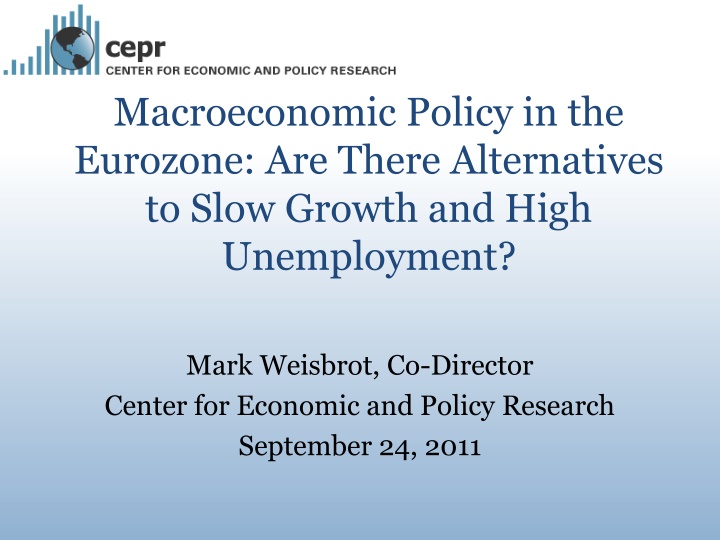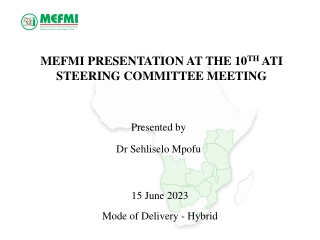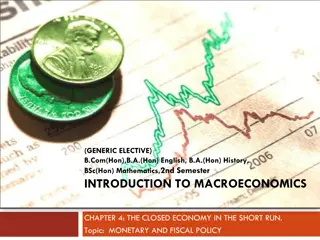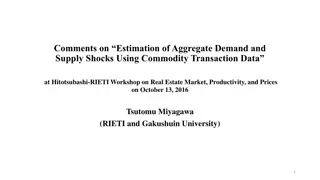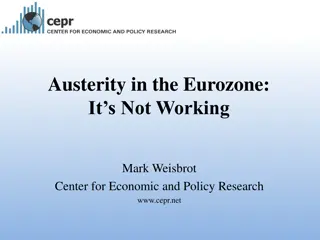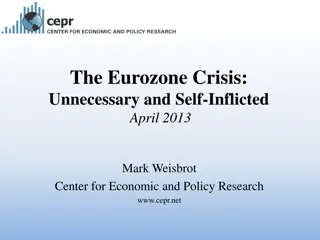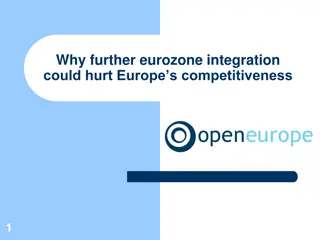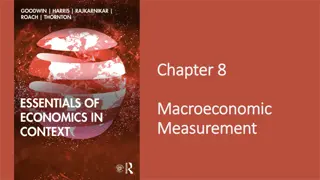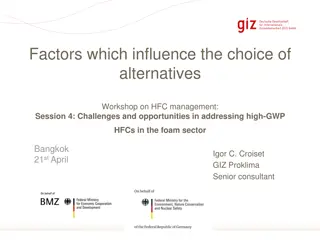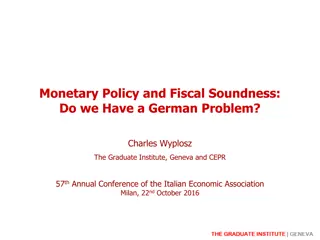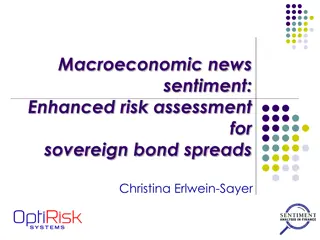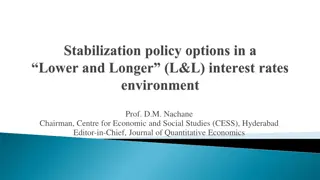Macroeconomic Policy in the Eurozone: Challenges and Alternatives
The macroeconomic policies in the Eurozone led by the Troika (ECB, European Commission, IMF) have been criticized for contributing to slow growth and high unemployment. This analysis by Mark Weisbrot delves into the negative impact of fiscal, monetary, and exchange rate policies on troubled economies like Greece, Ireland, Portugal, Spain, and Italy. Through data on real GDP trends, it highlights the failures and brinkmanship of the Troika, shedding light on the need for alternative approaches to address the Eurozone's economic crisis.
Download Presentation

Please find below an Image/Link to download the presentation.
The content on the website is provided AS IS for your information and personal use only. It may not be sold, licensed, or shared on other websites without obtaining consent from the author.If you encounter any issues during the download, it is possible that the publisher has removed the file from their server.
You are allowed to download the files provided on this website for personal or commercial use, subject to the condition that they are used lawfully. All files are the property of their respective owners.
The content on the website is provided AS IS for your information and personal use only. It may not be sold, licensed, or shared on other websites without obtaining consent from the author.
E N D
Presentation Transcript
Macroeconomic Policy in the Eurozone: Are There Alternatives to Slow Growth and High Unemployment? Mark Weisbrot, Co-Director Center for Economic and Policy Research September 24, 2011
Europes crisis, stagnation, and unemployment are not the result of unsustainable borrowing It is the result of bad macroeconomic policies from the European authorities: The Troika European Central Bank, European Commission, IMF
Three most important macroeconomic policies: Fiscal, monetary, and exchange rate Not helping, or actively causing damage, in troubled eurozone economies (Greece, Ireland, Portugal, Spain, Italy)
Troika, especially ECB has played game of brinksmanship with troubled economies since early 2010 Repeatedly pushing Europe, and now much of the world economy, to the edge of serious crisis Why?
Italy Real GDP (Index: 2007=100) 120 Trend WEO (spring) 115 WEO (fall) 110 105 100 99 99 100 98 97 96 96 95 95 94 95 90 85 2007 2008 2009 2010 2011(f) 2012(f) 2013(f) 2014(f) 2015(f) 2016(f) 20 16 17 16 15 14 15 12 11 11 10 3 5 0 0 Trend vs. Actual and Projected GDP (percent)
Ireland Real GDP (Index: 2007=100) 185 Trend WEO (spring) 175 WEO (fall) 165 155 145 135 125 115 102 105 100 99 96 96 93 91 95 90 90 89 85 2007 2008 2009 2010 2011(f) 2012(f) 2013(f) 2014(f) 2015(f) 2016(f) 68 64 59 54 60 48 42 34 40 26 10 20 0 0 Trend vs. Actual and Projected GDP (percent)
Greece Real GDP (Index: 2008=100) 135 Trend WEO (spring) 130 WEO (fall) 125 120 115 110 105 100 99 100 98 96 93 93 95 90 89 88 90 87 85 2007 2008 2009 2010 2011(f) 2012(f) 2013(f) 2014(f) 2015(f) 2016(f) 40 35 35 35 34 32 26 30 16 20 8 10 2 0 0 Trend vs. Actual and Projected GDP (percent)
Portugal Real GDP (Index: 2008=100) 135 Trend WEO (spring) 130 WEO (fall) 125 120 115 110 105 103 101 100 100 99 98 100 97 97 96 95 95 90 85 2007 2008 2009 2010 2011(f) 2012(f) 2013(f) 2014(f) 2015(f) 2016(f) 30 25 26 24 24 22 16 20 10 9 10 3 0 0 Trend vs. Actual and Projected GDP (percent)
Spain Real GDP (Index: 2008=100) 145 Trend WEO (spring) WEO (fall) 135 125 115 105 104 105 102 100 100 99 98 97 96 96 95 85 2007 2008 2009 2010 2011(f) 2012(f) 2013(f) 2014(f) 2015(f) 2016(f) 30 26 25 23 21 19 17 20 14 10 10 2 0 0 Trend vs. Actual and Projected GDP (percent)
Argentina Real GDP (Index: 1998=100) 130 125 Trend 125 Actual GDP 120 115 115 110 106 105 100 100 97 97 96 95 92 89 90 85 82 80 1998 1999 2000 2001 2002 2003 2004 2005 2006 2007 32 40 23 15 15 20 8 8 5 1 0 0 -5 -20 Trend vs. Actual GDP (percent)
Lessons from Argentina: Despite chaotic default, financial collapse, and no outside help, Argentine economy begins to recover just one quarter after default Argentina reaches pre-recession GDP within 3 years, despite much deeper recession compare to more than a decade in Greece.
Passes trend GDP in 2006 (compare to eurozone when?) Real GDP growth more than 90 percent 2002-2011 There are ALWAYS alternatives to the years of recession, stagnation, and high unemployment that the Troika is offering to the troubled eurozone economies
The human cost of economic mismanagement
Ireland Unemployment Rate (Seasonally Adjusted) 16 14 12 (percent) 10 8 6 4 2008 2009 2010 2011 Source: Eurostat
Greece Unemployment Rate (Seasonally Adjusted) 16 14 12 (percent) 10 8 6 4 2008 2009 2010 2011 Source: Eurostat
Italy Unemployment Rate (Seasonally Adjusted) 16 14 12 (percent) 10 8 6 4 2008 2009 2010 2011 Source: Eurostat
Portugal Unemployment Rate (Seasonally Adjusted) 16 14 12 (percent) 10 8 6 4 2008 2009 2010 2011 Source: Eurostat
Spain Unemployment Rate (Seasonally Adjusted) 22 20 18 16 (percent) 14 12 10 8 6 4 2008 2009 2010 2011 Source: Eurostat
Low inflation implies there is plenty of room for expansionary monetary and fiscal policies but eurozone countries that need it can t implement these policies
Ireland Inflation (Seasonally-Adjusted, year over year) 6.0 5.0 4.0 3.0 (percent) 2.0 1.0 0.0 -1.0 -2.0 -3.0 J F M A M J J A S O N D J F M A M J J A 2010 2011 Source: Eurostat
Greece Inflation (Seasonally-Adjusted, year over year) 6.0 5.0 4.0 3.0 (percent) 2.0 1.0 0.0 -1.0 -2.0 -3.0 J F M A M J J A S O N D J F M A M J J A 2010 2011 Source: Eurostat
Spain Inflation (Seasonally-Adjusted, year over year) 6.0 5.0 4.0 3.0 (percent) 2.0 1.0 0.0 -1.0 -2.0 -3.0 J F M A M J J A S O N D J F M A M J J A 2010 2011 Source: Eurostat
Italy Inflation (Seasonally-Adjusted, year over year) 6.0 5.0 4.0 3.0 (percent) 2.0 1.0 0.0 -1.0 -2.0 -3.0 J F M A M J J A S O N D J F M A M J J A 2010 2011 Source: Eurostat
Portugal Inflation (Seasonally-Adjusted, year over year) 6.0 5.0 4.0 3.0 (percent) 2.0 1.0 0.0 -1.0 -2.0 -3.0 J F M A M J J A S O N D J F M A M J J A 2010 2011 Source: Eurostat
Real Effective Exchange Rate (Based on Unit Labor Costs of 27 Trading Partners) 105 100 (Index: 2008QI=100) 95 Spain Ireland Portugal Greece Italy 90 I II III IV I II III IV I II III IV 2008 2009 2010 Source: Eurostat
Total Projected Fiscal Consolidation 2010-2016 (percentage points of GDP) Greece Ireland* Italy Portugal Spain 9 7.7 8 7.6 7.4 7 6 5.2 5 4 3.3 3 2 1 0 *Note: 2010 overall balance in Ireland excludes 21% of GDP in financial sector assistance. Source: IMF
Greece Projected Net Interest Payments (% of GDP) 9 8.5 8.4 7.9 7.7 8 7.2 6.7 7 6 5.5 5.5 (% of GDP) 5.2 5 4 3 2 1 0 2009 2010 2011(f) 2012(f) 2013(f) 2014(f) 2015(f) 2016(f) Source: IMF
Conclusion Euro zone crisis primarily a result of wrong macroeconomic policies European authorities will probably resolve current crisis with bigger EFSF or other rescue mechanisms, interventions in bond markets, bank bailouts, even Greek debt restructuring
Conclusion But continued wrong macroeconomic policies will cause unnecessary unemployment and suffering; cuts to health care, pensions, education; trillions of dollars in lost output, and possibly more crises
